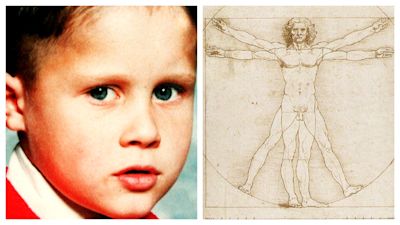Rikki Neave's mother wrongly accused of his murder because of Leonardo da Vinci's Vitruvian Man

The mother of Rikki Neave was wrongly accused of his murder after a picture was found at their home of Leonardo Da Vinci's Vitruvian Man - echoing the pose in which the schoolboy's body was discovered.
Six-year-old Rikki was found lying naked in the woods after he was strangled in November 1994, with his body arranged into a star shape, the Old Bailey heard.
James Watson, now 40, of no fixed address, is standing trial accused of his murder at the Old Bailey.
On the second day of his trial, the court heard how police investigating Rikki's murder in 1994 began to suspect his mother Ruth Neave after finding a book containing a picture of the famous drawing of Vitruvian Man at her Peterborough home.
Prosecutor John Price QC said: "It was said, as indeed is the case, that in one of its forms, the posture of the image resembles the way her son's naked body had been posed by his killer."
Ms Neave went on to be accused of killing him at the house and transferring the body in a buggy to the woods before reporting him missing, jurors heard.
But Mr Price told jurors sightings that day showed she could not have done it and she was acquitted after a trial.
The case remained unsolved for more than 20 years until a DNA breakthrough shed new light.
DNA belonging to child witness James Watson was identified on Rikki's trousers, which were among a bundle of clothes dumped in a bin near the woods.
Murder accused's 'story changed'
In his statement in 1994, Watson, then 13, said he had skipped school on the day of Rikki's death and gone to the Welland Estate in Peterborough where his father lived.
At around 12.30pm, he said he came across Rikki as he watched a digger in the road.
He told police he did not know the boy but recognised him from the estate.
According to his statement, Rikki said: "That's a big tractor isn't it?" to which Watson replied: "It's not a tractor, it's a digger."
He told police Rikki walked away and he did not see him again.
In 2016, Watson allegedly changed his story the day before being told of the new DNA evidence, suggesting he had picked Rikki up from behind under his armpits and held him up against a fence to look at the diggers.
Mr Price said the DNA added to a "substantial body" of evidence of other highly incriminating circumstances.
He said: "Ultimately the critical question for the jury in this case will be whether such a wide variety of evidence, including the DNA, just happens to combine to incriminate Watson for the simple reason that he is indeed the killer of Rikki Neave or whether, alternatively, may he be a hapless innocent victim of what would be the most extraordinary, implausible, and unfortunate set of coincidences."
Bogus radio report
Mr Price told jurors that Watson allegedly asked his mother about a bogus radio report of a child killing, three days before Rikki went missing.
He allegedly asked if it was true that “a two-year-old boy had been abducted from the Paston area of Peterborough and he had been strangled and left naked off the Paston Parkway”, and that the body was found by “the dyke”.
Mr Price said: “If Watson invented such a report of child murder on Friday 25 November 1994, what is one to make of the fact that only three days later, on the Monday, such a rare and terrible thing did happen in Peterborough?
“A local child did go missing. He wasn’t aged two, he was six. But this child really was murdered. This child was strangled. His body was found just off the Paston Parkway. It was by the dyke. It was naked.
“And this real child had been with the inventor of this bogus radio report on the day he went missing. And, when they were seen together, they were about three minutes’ walk from where his body was found.”
Asked about it in 2016, Watson said he could not recall saying it.
After the murder, he also allegedly displayed an interest in the case, making copies of a front page newspaper story.
Watson denies murder. The trial continues.